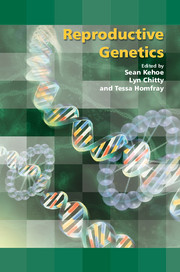Book contents
- Frontmatter
- Contents
- Participants
- Declarations of personal interest
- Preface
- 1 Genetic aetiology of infertility
- 2 Disorders of sex development
- 3 Preimplantation genetic diagnosis: current practice and future possibilities
- 4 Ethical aspects of saviour siblings: procreative reasons and the treatment of children
- 5 Epigenetics, assisted reproductive technologies and growth restriction
- 6 Fetal stem cell therapy
- 7 Prenatal gene therapy
- 8 Ethical aspects of stem cell therapy and gene therapy
- 9 Fetal dysmorphology: the role of the geneticist in the fetal medicine unit in targeting diagnostic tests
- 10 Fetal karyotyping: what should we be offering and how?
- 11 Non-invasive prenatal diagnosis: the future of prenatal genetic diagnosis?
- 12 Non-invasive prenatal diagnosis for fetal blood group status
- 13 Selective termination of pregnancy and preimplantation genetic diagnosis: some ethical issues in the interpretation of the legal criteria
- 14 Implementation and auditing of new genetics and tests: translating genetic tests into practice in the NHS
- 15 New advances in prenatal genetic testing: the parent perspective
- 16 Informed consent: what should we be doing?
- 17 Consensus views arising from the 57th Study Group: Reproductive Genetics
- Index
13 - Selective termination of pregnancy and preimplantation genetic diagnosis: some ethical issues in the interpretation of the legal criteria
Published online by Cambridge University Press: 05 February 2014
- Frontmatter
- Contents
- Participants
- Declarations of personal interest
- Preface
- 1 Genetic aetiology of infertility
- 2 Disorders of sex development
- 3 Preimplantation genetic diagnosis: current practice and future possibilities
- 4 Ethical aspects of saviour siblings: procreative reasons and the treatment of children
- 5 Epigenetics, assisted reproductive technologies and growth restriction
- 6 Fetal stem cell therapy
- 7 Prenatal gene therapy
- 8 Ethical aspects of stem cell therapy and gene therapy
- 9 Fetal dysmorphology: the role of the geneticist in the fetal medicine unit in targeting diagnostic tests
- 10 Fetal karyotyping: what should we be offering and how?
- 11 Non-invasive prenatal diagnosis: the future of prenatal genetic diagnosis?
- 12 Non-invasive prenatal diagnosis for fetal blood group status
- 13 Selective termination of pregnancy and preimplantation genetic diagnosis: some ethical issues in the interpretation of the legal criteria
- 14 Implementation and auditing of new genetics and tests: translating genetic tests into practice in the NHS
- 15 New advances in prenatal genetic testing: the parent perspective
- 16 Informed consent: what should we be doing?
- 17 Consensus views arising from the 57th Study Group: Reproductive Genetics
- Index
Summary
Introduction
This chapter considers some of the ethical issues at stake in the legal interpretation of the grounds for selective termination of pregnancy on the one hand and preimplantation genetic diagnosis (PGD) on the other. Termination of pregnancy is legal under section 1(1)(d) of the Abortion Act 1967 (as amended by the Human Fertilisation and Embryology [HFE] Act 1990) if two doctors have formed an opinion in good faith that ‘there is a substantial risk that if the child were born it would suffer from such physical or mental abnormalities as to be seriously handicapped’. These terms leave considerable scope for interpretation, particularly about what is meant by ‘seriously’, and to date there has been no direct judicial interpretation of this section. In a similar but not identical vein, PGD is legal if there is a significant risk ‘that a person … will have or develop a serious physical or mental disability, a serious illness or any other serious medical condition’. In both cases, then, great reliance is placed on the idea of seriousness. A certain degree of risk is also essential in both cases – a substantial risk in the context of termination of pregnancy and a significant risk in the case of PGD. In this chapter, I focus on some of the difficulties in interpreting seriousness in either context. My analysis will draw on a key and widely endorsed distinction in the bioethics literature between a life that may not be worth living and one that is worth living.
Keywords
- Type
- Chapter
- Information
- Reproductive Genetics , pp. 183 - 192Publisher: Cambridge University PressPrint publication year: 2009

